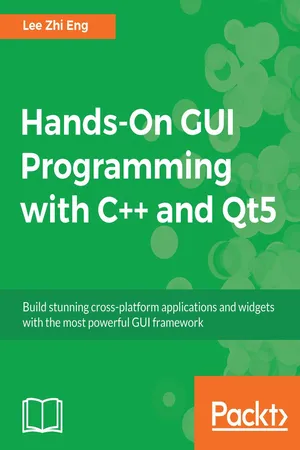
- 404 pages
- English
- ePUB (mobile friendly)
- Available on iOS & Android
Hands-On GUI Programming with C++ and Qt5
About this book
Create visually appealing and feature-rich applications by using Qt 5 and the C++ language
Key Features
- Explore Qt 5's powerful features to easily design your GUI application
- Leverage Qt 5 to build attractive cross-platform applications
- Work with Qt modules for multimedia, networking, and location, to customize your Qt applications
Book Description
Qt 5, the latest version of Qt, enables you to develop applications with complex user interfaces for multiple targets. It provides you with faster and smarter ways to create modern UIs and applications for multiple platforms. This book will teach you to design and build graphical user interfaces that are functional, appealing, and user-friendly.
In the initial part of the book, you will learn what Qt 5 is and what you can do with it. You will explore the Qt Designer, discover the different types of widgets generally used in Qt 5, and then connect your application to the database to perform dynamic operations. Next, you will be introduced to Qt 5 chart which allows you to easily render different types of graphs and charts and incorporate List View Widgets in your application. You will also work with various Qt modules, like QtLocation, QtWebEngine, and the networking module through the course of the book. Finally, we will focus on cross-platform development with QT 5 that enables you to code once and run it everywhere, including mobile platforms.
By the end of this book, you will have successfully learned about high-end GUI applications and will be capable of building many more powerful, cross-platform applications.
What you will learn
- Implement tools provided by Qt 5 to design a beautiful GUI
- Understand different types of graphs and charts supported by Qt 5
- Create a web browser using the Qt 5 WebEngine module and web view widget
- Connect to the MySQL database and display data obtained from it onto the Qt 5 GUI
- Incorporate the Qt 5 multimedia and networking module in your application
- Develop Google Map-like applications using Qt 5's location module
- Discover cross-platform development by exporting the Qt 5 application to different platforms
- Uncover the secrets behind debugging Qt 5 and C++ applications
Who this book is for
This book will appeal to developers and programmers who would like to build GUI-based applications. Basic knowledge of C++ is necessary and the basics of Qt would be helpful.
Frequently asked questions
- Essential is ideal for learners and professionals who enjoy exploring a wide range of subjects. Access the Essential Library with 800,000+ trusted titles and best-sellers across business, personal growth, and the humanities. Includes unlimited reading time and Standard Read Aloud voice.
- Complete: Perfect for advanced learners and researchers needing full, unrestricted access. Unlock 1.4M+ books across hundreds of subjects, including academic and specialized titles. The Complete Plan also includes advanced features like Premium Read Aloud and Research Assistant.
Please note we cannot support devices running on iOS 13 and Android 7 or earlier. Learn more about using the app.
Information
Database Connection
- Introducing the MySQL database system
- Setting up the MySQL database
- SQL commands
- Database connection in Qt
- Functional login page
- MySQL (or MariaDB)
- SQLite (version 2 and 3)
- IBM DB2
- Oracle
- ODBC
- PostgreSQL
- Sybase Adaptive Server
Introducing the MySQL database system

https://www.mysql.com
Setting up the MySQL database
- First, go to their website at https://www.apachefriends.org and click on one of the download buttons located at the bottom of your screen, w...
Table of contents
- Title Page
- Copyright and Credits
- Packt Upsell
- Contributors
- Preface
- Introduction to Qt
- Qt Widgets and Style Sheets
- Database Connection
- Graphs and Charts
- Item Views and Dialogs
- Integrating Web Content
- Map Viewer
- Graphics View
- The Camera Module
- Instant Messaging
- Implementing a Graphics Editor
- Cloud Storage
- Multimedia Viewers
- Qt Quick and QML
- Cross-Platform Development
- Testing and Debugging
- Other Books You May Enjoy